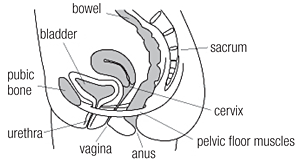The pelvic floor is a group of muscles and ligaments that support the bladder, uterus (womb) and bowel.
The openings from these organs, the urethra from the bladder, the vagina from the uterus and the anus from the bowel pass through the pelvic floor. The pelvic floor muscles attach to your pubic bone at the front and the tail bone at the back and from the base of your pelvis.
What do the pelvic floor muscles do?
When the pelvic floor is strong, it supports the pelvic organs to prevent problems such as:
- incontinence (the involuntary loss of urine or faeces)
- prolapse (lack of support) of the bladder, uterus and bowel.
The pelvic floor muscles also help you to control bladder and bowel function, such as allowing you to 'hold on' until an appropriate time and place.

What causes pelvic floor muscle weakness?
Some of the common causes of pelvic floor muscle weakness are:
- childbirth – particularly following delivery of a large baby or prolonged pushing during delivery
- being overweight
- constipation (excessive straining to empty your bowel)
- persistent heavy lifting
- excessive coughing – causing repetitive straining
- changes in hormonal levels at menopause
- growing older.
How do I strengthen my pelvic floor muscles?
It is recommended that all women exercise their pelvic floor muscles every day throughout life, to prevent weakness or improve strength. Exercising weak muscles regularly, over a period of time can strengthen them and make them work effectively again. Regular gentle exercise, such as walking can also help to strengthen your pelvic floor muscles.
Exercise 1
|
Step 1:
|
Sit, stand tall, lie on your back with your knees bent and legs comfortably apart or kneel on your hands and knees.
|
|---|---|
|
Step 2:
|
Close your eyes, imagine what muscles you would tighten to stop yourself from passing wind or to 'hold on' from passing urine. If you can’t feel a distinct tightening of these muscles, ask for some help from a women’s health physiotherapist. She will help you to get started.
|
|
Step 3:
|
Now that you can feel your pelvic floor muscles working, tighten them around your front passage, vagina and back passage as strongly as possible and hold for three to five seconds. By doing this, you should feel your pelvic floor muscles 'lift up' inside you and feel a definite 'let go' as the muscles relax. If you can hold longer (but no more than a maximum of eight seconds), then do so. Remember, the squeeze must stay strong and you should feel a definite 'let go'. Repeat up to ten times or until you feel your pelvic floor muscles fatigue. Rest for a few seconds in between each squeeze.
|
Steps one to three count as one exercise set. If you can, do three sets per day in different positions. Do your pelvic floor exercises every day for the rest of your life.
Exercise 2 (quick squeeze for power)
Squeeze and lift your pelvic floor muscles as strongly and as quickly as possible. Do not try to hold on to the contraction, just squeeze and let go. Rest for a few seconds in between each squeeze. Repeat this 10 to 20 times or until you feel your pelvic floor muscles fatigue.
If you can, do this exercise set one to three times per day.
During both exercises you should:
- feel your pelvic floor muscles 'lift up' inside you, rather than feel a downward movement
- relax your thighs and buttocks
- keep breathing normally
- stop exercising if your muscles fatigue.
Not sure where your pelvic floor is, or how to tone it once you’ve found it? Watch Dr Marg Sherburn from the Women’s as she demonstrates how to take care of those pelvic muscles.
What can I do to prevent damage?
To prevent damage to your pelvic floor muscles, avoid:
- constipation and/or straining with a bowel motion
- persistent heavy lifting
- repetitive coughing and straining
- putting on too much weight.
Make training part of your life by:
- tightening your pelvic floor muscles every time you cough, sneeze or lift
- doing some regular exercise, such as walking
- progressing your exercises by doing them during the day in different positions e.g. standing, sitting or on your hands and knees.
For many women, it is important to follow a specific exercise program tailored to their individual needs. If you are unsure of whether you are exercising your pelvic floor muscles correctly or you have urinary problems, you should make an appointment with a physiotherapist who specialise in women’s health.
Related information
Disclaimer
The Women’s does not accept any liability to any person for the information or advice (or use of such information or advice) which is provided on the Website or incorporated into it by reference. The Women’s provide this information on the understanding that all persons accessing it take responsibility for assessing its relevance and accuracy. Women are encouraged to discuss their health needs with a health practitioner. If you have concerns about your health, you should seek advice from your health care provider or if you require urgent care you should go to the nearest Emergency Dept.